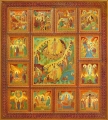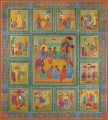|

The Saviour
|
|
Ascension of the Lord
Artist: Yuri Kuznetsov.
Technique: Tempera, wood panel with raised borders (“kovcheg”).
Size: 120 õ 35 cm.
Year: 2009 |
| The Ascension of the Lord is one of the twelve Christian festivals established after the memory of the Savior’s Ascension. The Festival is related to the Easter Cycle and celebrated on the fortieth day after Resurrection of Christ (Easter). The Festival of the “Ascension of Christ” is an introduction and preparation for the Festivities related to Descent of the Holy Spirit, to the day of Trinity. |
| |
| |
|
|
|
|
ALL The Saviour |

|
|
Ascension of the Lord
The Ascension of the Lord is one of the twelve Christian festivals established after the memory of the Savior’s Ascension. The Festival is related to the Easter Cycle and celebrated on the fortieth day after Resurrection of Christ (Easter). The Festival of the “Ascension of Christ” is an introduction and preparation for the Festivities related to Descent of the Holy Spirit, to the day of Trinity.
|

|
|
Ascension of the Lord
The Ascension of the Lord is one of the twelve Christian festivals established after the memory of the Savior’s Ascension. The Festival is related to the Easter Cycle and celebrated on the fortieth day after Resurrection of Christ (Easter). The Festival of the “Ascension of Christ” is an introduction and preparation for the Festivities related to Descent of the Holy Spirit, to the day of Trinity.
|
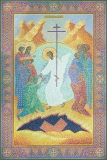
|
|
Resurrection of Christ
The Resurrection of Jesus Christ is the central event of Christian faith, its cornerstone. If not for the Resurrection of Christ not only Christianity would not have existed, but faith in God, in the power of good and truth, would probably have been undermined, the very sense of life of the Orthodox Christian would have been lost. The Luminous Resurrection of Christ, the Easter is the most ancient Christian festival, the most important in the liturgical year – the “Festival of Festivals” and the “Jubilance of All” as sung in the Eastern Canon.
|
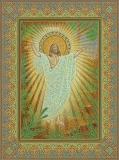
|
|
Resurrection of Christ
The Resurrection of Jesus Christ is the central event of Christian faith, its cornerstone. If not for the Resurrection of Christ not only Christianity would not have existed, but faith in God, in the power of good and truth, would probably have been undermined, the very sense of life of the Orthodox Christian would have been lost. The Luminous Resurrection of Christ, the Easter is the most ancient Christian festival, the most important in the liturgical year – the “Festival of Festivals” and the “Jubilance of All” as sung in the Eastern Canon.
|

|
|
Jesus in White Clothes
The “Jesus in White Clothes” icon is a copy of a 20th century icon painted by the metropolitan Seraphim.
Celebrating the Transfiguration of the Lord the Church solemnly confesses and glorifies the union of the divine and human in the person of Jesus Christ. In Russian tradition the Transfiguration of the Lord God and our Savior Jesus Christ is also called the Apple Savior or the Second Savior.
|

|
|
Jesus in White Clothes
The “Jesus in White Clothes” icon is a copy of a 20th century icon painted by the metropolitan Seraphim.
Celebrating the Transfiguration of the Lord the Church solemnly confesses and glorifies the union of the divine and human in the person of Jesus Christ. In Russian tradition the Transfiguration of the Lord God and our Savior Jesus Christ is also called the Apple Savior or the Second Savior.
|

|
|
The Multi-Image Icon
Images of different topics are gathered together on this icon, therefore it is called multi-image. Different events from the lives of the Savior Jesus Christ and the Most Holy Theotokos as well as the themes of great Church festivals are portrayed here. We can see on this icon – the Resurrection of Christ, Descent into hell, Erection of the True Cross of the Lord, Ascension of Christ, Christ’s Entry to Jerusalem, Transfiguration, Baptism of Christ, Holy Trinity, Presentation, Dormition of the Holy Theotokos, Annunciation, Introduction of the Theotokos to the Temple, Christmas, Birth of the Theotokos.
|
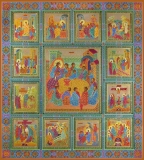
|
|
The Multi-Image Icon
Images of different topics are gathered here, that is why it is called multi-image. The Passion of Christ is intertwined with great Church festivals. This icon portrays: the Lord’s Supper, Mid-Pentecost of our Lord Jesus Christ, Bread Giving, Wine Giving to the Apostles, Lazarus Resurrection, Bringing to Pilate, Crucifixion, Descent of the Holy Spirit on the Apostles, Doubting of Thomas, Myrrh-Bearing Women at the Holy Sepulchre, Deposition from the Cross, Road to Calvary, Foot Washing.
|

|
|
Praying about the Cup
Praying about the cup is a prayer of Jesus Christ in the garden of Gethsemane shortly before his arrest. The Savior, bending the knee, was praying and said: “Father, if thou be willing, remove this cup from me: nevertheless not my will, but thine, be done” (Luke 22:42). John Damascene interprets this prayer of the Savior this way: “The Lord according to His human nature was in struggle and fear. He was praying to avoid death. But since His divine will was willing that His human will would receive death – the suffering became willful and according to Christ’s humanity”
|

|
|
Transfiguration of the Lord
In order to support faith in His disciples shortly before His passion Jesus Christ showed them His divine glory: “… And was transfigured before them: and his face did shine as the sun, and his raiment was white as the light”. (Mt. 17:1-13; Mk. 9:2-13; Lk. 9: 28-36) The Savior’s Transfiguration is a prototype of people in the Kingdom of God, a future transfiguration of the whole earthly world.
|

|
|
Transfiguration of the Lord
In order to support faith in His disciples shortly before His passion Jesus Christ showed them His divine glory: “… And was transfigured before them: and his face did shine as the sun, and his raiment was white as the light”. (Mt. 17:1-13; Mk. 9:2-13; Lk. 9: 28-36) The Savior’s Transfiguration is a prototype of people in the Kingdom of God, a future transfiguration of the whole earthly world.
|
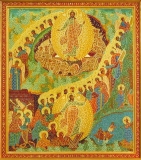
|
|
Resurrection. Descent into Hell
The descent into hell completes the expiatory mission of Jesus Christ. While the body of Christ was in the tomb His human soul descended to the depths of hell and preached to the souls of the deceased thereby setting them free. The Savior led the souls of Old Testament righteous people out including Adam and Eve. There is almost no mention in the canonical Gospels about the descent of Jesus Christ to hell. This event is described in much more detail in the apocryphal “Gospel according to Nicodemus.”
|
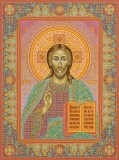
|
|
Savior the Pantocrator
“Savior the Pantocrator” often referred to as “The Savior” is a central image in the iconography of Christ presenting Him as the Heavenly King. “I am Alpha and Omega, the beginning and the ending, saith the Lord, which is, and which was, and which is to come, the Almighty.” The main physician of souls and bodies who knows everything and to whom primarily we should address our prayers. At times depression and desperation get to the heart but the Savior will always reach out with His helping hand and our faith and hope will come back to life.
|

|
|
Savior the Pantocrator
“Savior the Pantocrator” often referred to as “The Savior” is a central image in the iconography of Christ presenting Him as the Heavenly King. “I am Alpha and Omega, the beginning and the ending, saith the Lord, which is, and which was, and which is to come, the Almighty.” The main physician of souls and bodies who knows everything and to whom primarily we should address our prayers. At times depression and desperation get to the heart but the Savior will always reach out with His helping hand and our faith and hope will come back to life.
|

|
|
The Holy Mandylion
The “Holy Mandylion” icon by an icon painter Yuriy Kuznetsov is created according to ancient monastic traditions and well preserved. This icon participated in exhibitions dedicated to the spiritual rebirth of modern art. The image of Christ lit the whole life path of the Ancient Rus man from birth to his last breath. In the Image of Christ he could see the sense and justification of his life, embodying his sense of faith in lofty images as clear as a prayer’s words.
|
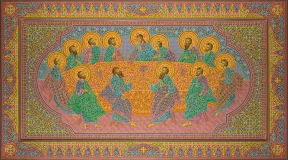
|
|
The Holy Supper
After eating the Old Testament Jewish Passover Jesus Christ instituted at this supper the Sacrament of Holy Communion. Therefore it is called “The Holy Supper”. The Savior gave His disciples under the likeness of bread and wine the same Body and the same Blood that he would give for suffering and death for our sins the next day. The Lord gave commandment to always administer this sacrament, saying: “Do this in remembrance of me.” (Mt. 26:17-35; Mk. 14:12-31; Lk. 22:7-39; Jn. 13-18)
|

|
|
The Holy Supper
After eating the Old Testament Jewish Passover Jesus Christ instituted at this supper the Sacrament of Holy Communion. Therefore it is called “The Holy Supper”. The Savior gave His disciples under the likeness of bread and wine the same Body and the same Blood that he would give for suffering and death for our sins the next day. The Lord gave commandment to always administer this sacrament, saying: “Do this in remembrance of me.” (Mt. 26:17-35; Mk. 14:12-31; Lk. 22:7-39; Jn. 13-18)
|

|
|
Christ the Ardent Eye
This is a head-and-shoulder image of Christ with a sorrowful dark countenance and a stern and penetrating look. This icon was especially popular in Rus in the Golden Horde times. A major internal tension of the image agreed with the spirit of those times. The words of Jesus Christ “I came not to send peace, but a sword” are the best emotional match to His “Christ the Ardent Eye” portrait.
|

|
|
Christ the Ardent Eye
This is a head-and-shoulder image of Christ with a sorrowful dark countenance and a stern and penetrating look. This icon was especially popular in Rus in the Golden Horde times. A major internal tension of the image agreed with the spirit of those times. The words of Jesus Christ “I came not to send peace, but a sword” are the best emotional match to His “Christ the Ardent Eye” portrait.
|

|
|
Christ the Ardent Eye
This is a head-and-shoulder image of Christ with a sorrowful dark countenance and a stern and penetrating look. This icon was especially popular in Rus in the Golden Horde times. A major internal tension of the image agreed with the spirit of those times. The words of Jesus Christ “I came not to send peace, but a sword” are the best emotional match to His “Christ the Ardent Eye” portrait.
|
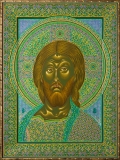
|
|
Christ the Ardent Eye
This is a head-and-shoulder image of Christ with a sorrowful dark countenance and a stern and penetrating look. This icon was especially popular in Rus in the Golden Horde times. A major internal tension of the image agreed with the spirit of those times. The words of Jesus Christ “I came not to send peace, but a sword” are the best emotional match to His “Christ the Ardent Eye” portrait.
|
| To go back into beginning |
|
|
|

